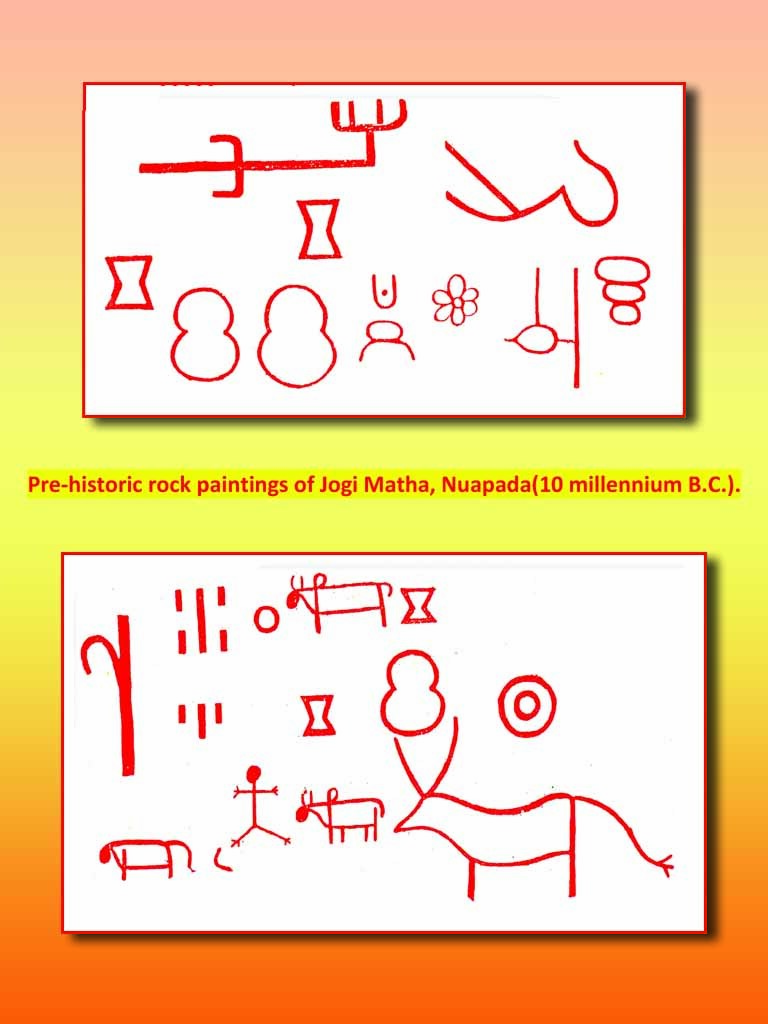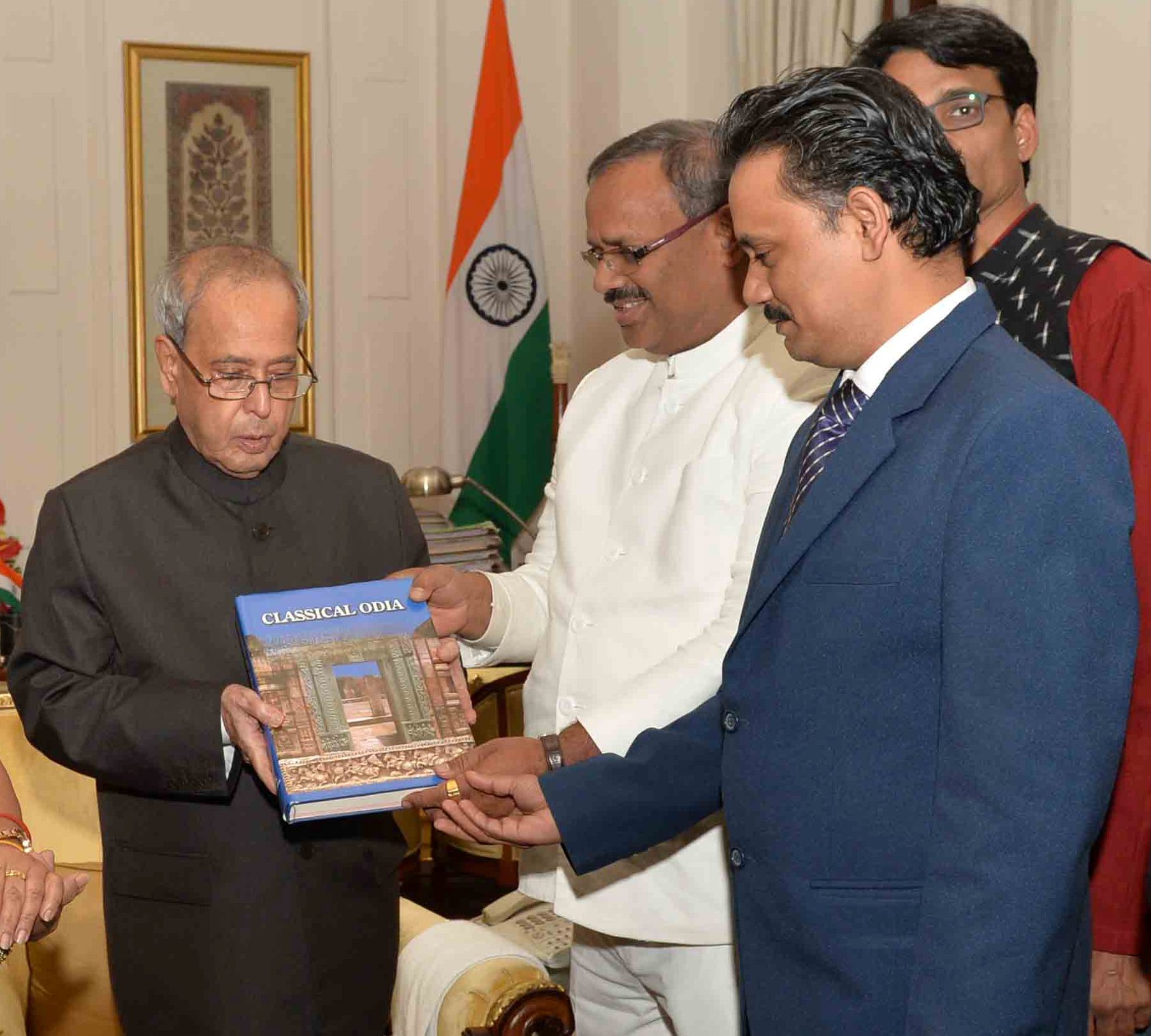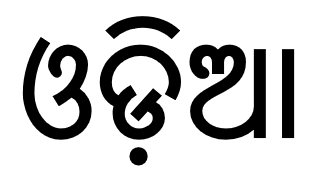|
Yogimatha
Yogimath is situated in Nuapada district at a distance of about 9 km from Khariar western Odisha border area and 67 km from Bhawanipatna of Kalahandi District. This place is famous for its neolithic cave paintings. In Yogimath caves the paintings are drawn by red paint over rock surfaces. The most significant pictures are of a bull followed by cow, calf and a man indicating the domestication of animal by man and agriculture. The past glory of this place is still unexplored. Near Yogimath, there is a mountain named Risipiti which is well known for producing clear echoes. History On the basis of art style, colour composition of the motifs, the paintings can be dated to the Mesolithic-Chalcolithic periods. The paintings at Gudahandi of kalahandi may be placed about 15th millennium B.C., but those at yogimath are somewhat of later period and may be assigned to about 10th millennium B.C. The painting are largely disfigure by human vandalism and superimposition of ritualistic sy ... [...More Info...] [...Related Items...] OR: [Wikipedia] [Google] [Baidu] |
Subrat Kumar Prusty
Subrat Kumar Prusty (born 1976) is an Indian Odia-language scholar, activist, social entrepreneur, literary critic and author. He is Member Secretary of the Institute of Odia Studies and Research, Bhubaneswar, Odisha. He was instrumental in preparing the research documents, advocating the awarding of Classical Language status to Odia, forming Central Institute of Classical Odia, Odia University and implementation of the Odisha Official Language Act, 1954. He was awarded the Presidential Certificate of Honour and Maharshi Badrayan Vyas Samman – 2019 for Classical Odia. Early life and education Dr. Subrat Kumar Prusty was born the third son of Late Rajkishore Prusty and Indumati Prusty in the village of Bidyadharpur, near Jajpur Town, the oldest capital of Odisha situated on the banks of Budha, a tributary of the Holy Baitarani. After his schooling at Sudarshan Padhi High School, he chose to join N.C. College Jajpur (then affiliated with Utkal University, where he did his B.A ... [...More Info...] [...Related Items...] OR: [Wikipedia] [Google] [Baidu] |
Vikramkhol Cave Inscription
Vikramkhol or Bikramkhol cave is a prehistoric archaeological site known for prehistoric inscriptions. Location Vikramkhol cave is located near Jharsuguda, Odisha, India and lies in Reserved Forest of Belpahar range, at a distance of 12 km from Belpahar. Inscriptions The inscriptions at Vikramkhol cave are written on an uneven rock surface in a natural rock shelter using red Ochre paint which is later incised into the rock. The inscriptions were discovered around the 1930s and first studied by Dr K P Jayaswal. who tentatively dates it 1500 BC. There are two theories regarding the inscription – one declares it a writing, while others doubt it as a rock art and nonliterate rock carvings Theory of literate script According to Jayaswal, the prehistoric scribblings at Vikramkhol represent a picto-syllabic writing system which represents a mixture of Harappan and Brahmi hence forming a connection between the two. The inscribed portion covers an area of 35 feet by 7 feet, The e ... [...More Info...] [...Related Items...] OR: [Wikipedia] [Google] [Baidu] |
Rock Art
In archaeology, rock art is human-made markings placed on natural surfaces, typically vertical stone surfaces. A high proportion of surviving historic and prehistoric rock art is found in caves or partly enclosed rock shelters; this type also may be called cave art or parietal art. A global phenomenon, rock art is found in many culturally diverse regions of the world. It has been produced in many contexts throughout human history. In terms of technique, the four main groups are: * cave paintings, * petroglyphs, which are carved or scratched into the rock surface, * sculpted rock reliefs, and * geoglyphs, which are formed on the ground. The oldest known rock art dates from the Upper Palaeolithic period, having been found in Europe, Australia, Asia, and Africa. Anthropologists studying these artworks believe that they likely had magico-religious significance. The archaeological sub-discipline of rock art studies first developed in the late-19th century among Francophone scholar ... [...More Info...] [...Related Items...] OR: [Wikipedia] [Google] [Baidu] |
Odia Language
Odia (, ISO: , ; formerly rendered Oriya ) is an Indo-Aryan language spoken in the Indian state of Odisha. It is the official language in Odisha (formerly rendered Orissa), where native speakers make up 82% of the population, and it is also spoken in parts of West Bengal, Jharkhand, Andhra Pradesh and Chhattisgarh. Odia is one of the many official languages of India; it is the official language of Odisha and the second official language of Jharkhand. The language is also spoken by a sizeable population of 700,000 people in Chhattisgarh. Odia is the sixth Indian language to be designated a classical language, on the basis of having a long literary history and not having borrowed extensively from other languages. The earliest known inscription in Odia dates back to the 10th century CE. History Odia is an Eastern Indo-Aryan language belonging to the Indo-Aryan language family. It descends from Odra Prakrit, which evolved from Magadhi Prakrit, which was spoken in east I ... [...More Info...] [...Related Items...] OR: [Wikipedia] [Google] [Baidu] |
Rock Shelters
A rock shelter (also rockhouse, crepuscular cave, bluff shelter, or abri) is a shallow cave-like opening at the base of a bluff or cliff. In contrast to solutional caves (karst), which are often many miles long, rock shelters are almost always modest in size and extent. Formation Rock shelters form because a rock stratum such as sandstone that is resistant to erosion and weathering has formed a cliff or bluff, but a softer stratum, more subject to erosion and weathering, lies just below the resistant stratum, and thus undercuts the cliff. In arid areas, wind erosion ( Aeolian erosion) can be an important factor in rockhouse formation. In most humid areas, the most important factor in rockhouse formation is frost spalling, where the softer, more porous rock underneath is pushed off, tiny pieces at a time, by frost expansion from water frozen in the pores. Erosion from moving water is seldom a significant factor. Many rock shelters are found under waterfalls. File:Ro ... [...More Info...] [...Related Items...] OR: [Wikipedia] [Google] [Baidu] |
Caves Containing Pictograms In India
A cave or cavern is a natural void in the ground, specifically a space large enough for a human to enter. Caves often form by the weathering of rock and often extend deep underground. The word ''cave'' can refer to smaller openings such as sea caves, rock shelters, and grottos, that extend a relatively short distance into the rock and they are called ''exogene'' caves. Caves which extend further underground than the opening is wide are called ''endogene'' caves. Speleology is the science of exploration and study of all aspects of caves and the cave environment. Visiting or exploring caves for recreation may be called ''caving'', ''potholing'', or ''spelunking''. Formation types The formation and development of caves is known as '' speleogenesis''; it can occur over the course of millions of years. Caves can range widely in size, and are formed by various geological processes. These may involve a combination of chemical processes, erosion by water, tectonic forces, microorganis ... [...More Info...] [...Related Items...] OR: [Wikipedia] [Google] [Baidu] |
Pre-Brahmi Script
The Brahmic scripts, also known as Indic scripts, are a family of abugida writing systems. They are used throughout the Indian subcontinent, Southeast Asia and parts of East Asia. They are descended from the Brahmi script of ancient India and are used by various languages in several language families in South, East and Southeast Asia: Indo-Aryan, Dravidian, Tibeto-Burman, Mongolic, Austroasiatic, Austronesian, and Tai. They were also the source of the dictionary order ('' gojūon'') of Japanese '' kana''. History Brahmic scripts descended from the Brahmi script. Brahmi is clearly attested from the 3rd century BCE during the reign of Ashoka, who used the script for imperial edicts, but there are some claims of earlier epigraphy found on pottery in southern India and Sri Lanka. The most reliable of these were short Brahmi inscriptions dated to the 4th century BCE and published by Coningham et al. (1996). Northern Brahmi gave rise to the Gupta script ... [...More Info...] [...Related Items...] OR: [Wikipedia] [Google] [Baidu] |
Jaugada Inscription
Jaugada ("Jaugarh", ancient Samapa) is a ruined fortress in the Ganjam district in Odisha, India. Jaugada lies 35 km north-west of Brahmapur and 160 km south-west of Bhubaneshwar. Once a provincial Mauryan fortified capital of the newly conquered province of Kalinga, Jaugada is famous for its version of the monumental stone-cut edicts in Prakrit of the Mauryan emperor Ashoka. Despite J.D. Beglar's description during the later 19th century of the extant fortification towers and moat ("The walls had towers, also of earth, at each of the four corners, and also on each flank of each of the eight entrances"), without photos and drawings, the remains are difficult to visualize and comprehend. In 1956 Debala Mitra of the Archaeological Survey of India transected the northern glacis with a trench. The now collapsed trench of this investigation appears to lie just east of the eastern gate of the north wall. It is near the great Shiva temple Kaleswar & Rameswar (which ... [...More Info...] [...Related Items...] OR: [Wikipedia] [Google] [Baidu] |
Dhauli
Dhauli or Dhauligiri is a hill located on the banks of the river Daya, 8 km south of Bhubaneswar in Odisha, India. Significance Dhauli known for "Dhauli Santi Stupa", a peace pagoda monument which witnesses the great Kalinga War built by Japan Budhha Sangha and Kalinga Nippon Budhha Sangha. Dhauli hill is presumed to be the area where the Kalinga War The Kalinga War (ended )Le Huu Phuoc, Buddhist Architecture, Grafikol 2009, p.30 was fought in ancient India between the Maurya Empire under Ashoka and the state of Kalinga, an independent feudal kingdom located on the east coast, in the p ... was fought. Imagary File:Dhauli Light and Sound Show.jpg, Picture of Dhauli Light and Sound Show File:Dhauli Light and Sound show.jpg, Light and sound show in Dhaulagiri File:Dhauligiri Buddha Statue.JPG, Sleeping Buddha statue at Dhauli Shanti Stupa File:Dhauli Giri Lion bbsr orissa.jpg, Lion Sculpture at the entrance of Dhauli Shanti Stupa References External lin ... [...More Info...] [...Related Items...] OR: [Wikipedia] [Google] [Baidu] |
Writing System
A writing system is a method of visually representing verbal communication, based on a script and a set of rules regulating its use. While both writing and speech are useful in conveying messages, writing differs in also being a reliable form of information storage and transfer. Writing systems require shared understanding between writers and readers of the meaning behind the sets of characters that make up a script. Writing is usually recorded onto a durable medium, such as paper or electronic storage, although non-durable methods may also be used, such as writing on a computer display, on a blackboard, in sand, or by skywriting. Reading a text can be accomplished purely in the mind as an internal process, or expressed orally. Writing systems can be placed into broad categories such as alphabets, syllabaries, or logographies, although any particular system may have attributes of more than one category. In the alphabetic category, a standard set of letters represent ... [...More Info...] [...Related Items...] OR: [Wikipedia] [Google] [Baidu] |









